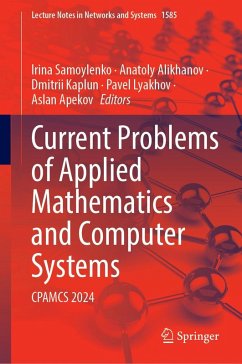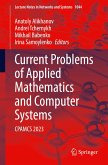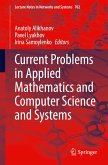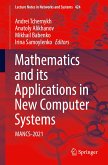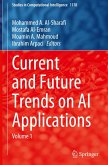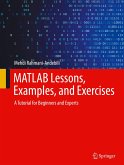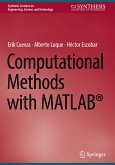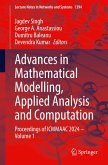Current Problems of Applied Mathematics and Computer Systems
CPAMCS 2024
Herausgegeben:Samoylenko, Irina; Alikhanov, Anatoly; Kaplun, Dmitrii; Lyakhov, Pavel; Apekov, Aslan
Current Problems of Applied Mathematics and Computer Systems
CPAMCS 2024
Herausgegeben:Samoylenko, Irina; Alikhanov, Anatoly; Kaplun, Dmitrii; Lyakhov, Pavel; Apekov, Aslan
- Gebundenes Buch
- Merkliste
- Auf die Merkliste
- Bewerten Bewerten
- Teilen
- Produkt teilen
- Produkterinnerung
- Produkterinnerung
This book based on the best papers accepted for presentation during the International Conference on Current Problems of Applied Mathematics and Computer Systems (CPAMCS-2024), Russia. This book includes research focused on contemporary mathematical challenges and their resolutions within scientific computing, data analysis and modular computing. This book presents original studies on numerical methods in scientific computing, optimization problem-solving, function approximation techniques, among other topics. Furthermore, it encompasses research contributions in data analysis and modular…mehr
Andere Kunden interessierten sich auch für
![Current Problems of Applied Mathematics and Computer Systems Current Problems of Applied Mathematics and Computer Systems]() Current Problems of Applied Mathematics and Computer Systems151,99 €
Current Problems of Applied Mathematics and Computer Systems151,99 €![Current Problems in Applied Mathematics and Computer Science and Systems Current Problems in Applied Mathematics and Computer Science and Systems]() Current Problems in Applied Mathematics and Computer Science and Systems151,99 €
Current Problems in Applied Mathematics and Computer Science and Systems151,99 €![Mathematics and its Applications in New Computer Systems Mathematics and its Applications in New Computer Systems]() Mathematics and its Applications in New Computer Systems171,19 €
Mathematics and its Applications in New Computer Systems171,19 €![Current and Future Trends on AI Applications Current and Future Trends on AI Applications]() Current and Future Trends on AI Applications174,99 €
Current and Future Trends on AI Applications174,99 €![MATLAB Lessons, Examples, and Exercises MATLAB Lessons, Examples, and Exercises]() Mehdi Rahmani-AndebiliMATLAB Lessons, Examples, and Exercises39,99 €
Mehdi Rahmani-AndebiliMATLAB Lessons, Examples, and Exercises39,99 €![Computational Methods with MATLAB® Computational Methods with MATLAB®]() Erik CuevasComputational Methods with MATLAB®42,99 €
Erik CuevasComputational Methods with MATLAB®42,99 €![Advances in Mathematical Modelling, Applied Analysis and Computation Advances in Mathematical Modelling, Applied Analysis and Computation]() Advances in Mathematical Modelling, Applied Analysis and Computation151,99 €
Advances in Mathematical Modelling, Applied Analysis and Computation151,99 €-
-
-
This book based on the best papers accepted for presentation during the International Conference on Current Problems of Applied Mathematics and Computer Systems (CPAMCS-2024), Russia. This book includes research focused on contemporary mathematical challenges and their resolutions within scientific computing, data analysis and modular computing. This book presents original studies on numerical methods in scientific computing, optimization problem-solving, function approximation techniques, among other topics. Furthermore, it encompasses research contributions in data analysis and modular computing, highlighting advancements in deep learning, neural networks, mathematical statistics, machine learning techniques, residue number systems and artificial intelligence. Additionally, this book addresses critical issues in mathematical education. This book intends for professionals engaged in scientific computing, parallel computing, computer technology, machine learning, information security, and mathematics education.
Produktdetails
- Produktdetails
- Lecture Notes in Networks and Systems 1585
- Verlag: Springer / Springer Nature Switzerland / Springer, Berlin
- Artikelnr. des Verlages: 978-3-032-01830-4
- Seitenzahl: 536
- Erscheinungstermin: 18. Oktober 2025
- Englisch
- Abmessung: 241mm x 160mm x 35mm
- Gewicht: 961g
- ISBN-13: 9783032018304
- ISBN-10: 3032018307
- Artikelnr.: 74819564
- Herstellerkennzeichnung
- Springer-Verlag KG
- Sachsenplatz 4-6
- 1201 Wien, AT
- ProductSafety@springernature.com
- Lecture Notes in Networks and Systems 1585
- Verlag: Springer / Springer Nature Switzerland / Springer, Berlin
- Artikelnr. des Verlages: 978-3-032-01830-4
- Seitenzahl: 536
- Erscheinungstermin: 18. Oktober 2025
- Englisch
- Abmessung: 241mm x 160mm x 35mm
- Gewicht: 961g
- ISBN-13: 9783032018304
- ISBN-10: 3032018307
- Artikelnr.: 74819564
- Herstellerkennzeichnung
- Springer-Verlag KG
- Sachsenplatz 4-6
- 1201 Wien, AT
- ProductSafety@springernature.com
Anatoly Alikhanov has obtained his Ph.D. in Physical and Mathematical Sciences and currently holds the position of Professor, Vice-Rector for Scientific and Research Work and the Head of the Regional Scientific and Educational Mathematical Center “North Caucasian Center for Mathematical Research” at North-Caucasus Federal University, Stavropol, Russia. Alikhanov has an extensive publication record, with publications in high-ranked journals. His academic excellence has been recognized in “The Single Recent Year Data Ranking of World’s Top 2% Scientists,” compiled by Stanford University, for the years 2019 through 2023. He previously served as a Visiting Member of the Dissertation Council at the Department of Mathematics, Southeast University, Nanjing, China. In 2016 and 2023, he was invited to undertake internships at Nanjing University, focusing on numerical methods for solving fractional differential equations. Dmitrii Kaplun is Ph.D. (2009), Associate Professor (2015), Lead Researcher at Saint Petersburg Electrotechnical University “LETI” (Saint Petersburg, Russia), Full Professor (2023) at China University of Mining and Technology (Xuzhou, China). In 2009 he defended his PhD thesis in computer science at Saint Petersburg Electrotechnical University “LETI.” The current research and academic work are related to digital signal and image processing, embedded and reconfigurable systems, computer vision and machine learning. Author of more than 150 papers in journals and conference proceedings. Kaplun has been an Editorial Board Member for Scientific Reports since 2022 and Associate Editor for Industrial Artificial Intelligence journal since 2023. Pavel Lyakhov received the degree in mathematics from Stavropol State University, in 2009, and the Ph.D. degree in physical and mathematical sciences, in 2012. Currently, he is the Head of the Department of Mathematical Modeling, North-Caucasus Federal University. He is the author of more than 170 scientific articles and the holder of 28 copyright certificates and patents. His research interests include high-performance computing, residual class system arithmetic, machine learning, artificial intelligence, and medical imaging. Aslan Apekov has obtained his Ph.D. in Physical and Mathematical Sciences. He is the Deputy Director for Research at the North-Caucasus Center for Mathematical Research and the Head of the Computational Methods Department at the North-Caucasus Federal University. He received a PhD in Condensed Matter Physics. He supervised applied research on the topic of Development and Study of Image Reconstruction Methods for a Multifunctional X-ray Diagnostic Complex with Digital Tomosynthesis Function. His research interests include the physics of interphase phenomena, mathematical modeling of physical processes, and computational physics. Irina Samoylenko is Ph.D., Associate Professor at Informational Systems Department, Stavropol State Agrarian University, Russia. She received M.S. degree in Applied Mathematics and Informatics, Ph.D. in System Analysis, Control and Processing of Information in North-Caucasus Federal University. She is a member of Association of Scientific Editors and Publishers, Russia. She participated in international conferences and internships in Italy, Turkey, Romania, Serbia and Czech Republic. Her research interests include wireless sensor networks, optimization tasks, IoT in agriculture. Irina has been an Editor of various international conferences from publishing houses including Springer, Institute of Physics, American Institute of Physics etc. She has publications in reputed international journals, such as Ad-Hoc, Computers and Electronics in Agriculture, Computer Communications.
Part I: Numerical Methods in Scientific Computing.- Research of dynamics of the ekranoplan movement.- Bending oscillations of the vertical rack.- Stability of finite-difference schemes for the fractional differential equation of fluid filtration in porous media.- Implicit Time Approximations for Hyperbolic Equations.- Numerical modeling of gas transportation systems.- Lyapunov Stability Analysis for Systems of Nonlinear Ordinary Differential Equations Based on Additive Transformations of the Finite Difference Formula.- Differential approach to detecting wake vortices by lidar remote sensing data.- Resolving implicitness in semi-implicit numerical integration schemes using fixed-point iterations.- Operator-difference approximations on two-dimensional merged Voronoi-Delaunay grids.- Stability analysis of an L2 type numerical scheme for the Steklov nonlocal boundary value problems in time-fractional diffusion equations.- Part II: Information and Computation Systems for Distributed Environments.- The algorithm of load distribution between computing resources of the data processing center.- Residue number system division based on inverse conversion and Akushsky core function.- Comparative analysis of dipfakes detection methods.- Application of redundant residue number system for fault tolerance of computing systems.- AI-Powered Disaster Management System Using Satellite Imagery: a Survey.- Homomorphic data encryption system based on residue number system.- Comparative analysis of parameters of attacks and incidents on cyber-physical systems.- Unmanned automated system control platform.- Neural network algorithm for solving the differential equation of interindustry balance.- Statistical modeling of mechanical properties of blast-compacted soils.- Part III: High performance computing and artificial intelligence.- The method of ensembling neural networks for pattern recognition.- Video analysis of an unmanned aerial vehicle in low signal conditions.- Modified U-Net for the segmentation of sunflower leaf from photographs.- Design and software implementation of the Windows desktop application "Bioeconomic diagnostics of health care".- Can a single neuron model be used as an accurate time-series classifier?.- Characterization of a Desktop Grid performance.- Non-coherent chaotic communication system based on return map quantification.- Improving the balance of RNS by using the metric of finding optimal sets of Low-Cost and 2k + 1 modules.- Implementation of a 2n-1 binary adder based on cellular automata technology.- Model of RF fingerprinting of wireless devices based on signal correlation.- Part IV: Current problems of mathematical education.- Use of computer systems in mathematical modeling.- The application of mathematical methods in digital image processing.- Methodological system of professionally oriented teaching of mathematics to students of the medical university.- Part V: Mathematical modeling of nonlinear physical phenomena.- Internal inertial-gravity waves in a polytropic atmosphere.- Using the OpenFOAM Package for Modeling Turbulent Gas Flow in a Shaped Pipe.- Mathematical model of pulse wave.- Automodel solutions of complex nonlinear partial differential equation, possessing Lax pair.- Soliton solutions to perturbation of the Korteweg-de Vries equation.- Channel model analysis for maritime wireless broadband communication systems for coastal autonomous and remote navigation.- Development of an algorithm for converting quaternion s in solving problems without crew navigation.- Dynamic Stochastic Modeling of Competitive Interaction Between Two Firms of Car Manufacturers.- Mathematical modeling spread of viral diseases.- Robust control methods of universal multipurpose towed complexes.- In-Depth Analysis of the Stress-Strain State of the Three-Section Floating Dock PD-190 "MOSOR" Project Under Dynamic Loads.- Scattering data of a nonlinear partial differential equation with a Lax pair with a Dirac scattering operator of the first kind.- Iterative solutions of the incompressible fluid flow in a lid-driven cavity at large Reynolds numbers.- Modeling of the Interfacial Energy of Plumbum Faces at the Boundary with Organic Liquids.
Part I: Numerical Methods in Scientific Computing.- Research of dynamics of the ekranoplan movement.- Bending oscillations of the vertical rack.- Stability of finite-difference schemes for the fractional differential equation of fluid filtration in porous media.- Implicit Time Approximations for Hyperbolic Equations.- Numerical modeling of gas transportation systems.- Lyapunov Stability Analysis for Systems of Nonlinear Ordinary Differential Equations Based on Additive Transformations of the Finite Difference Formula.- Differential approach to detecting wake vortices by lidar remote sensing data.- Resolving implicitness in semi-implicit numerical integration schemes using fixed-point iterations.- Operator-difference approximations on two-dimensional merged Voronoi-Delaunay grids.- Stability analysis of an L2 type numerical scheme for the Steklov nonlocal boundary value problems in time-fractional diffusion equations.- Part II: Information and Computation Systems for Distributed Environments.- The algorithm of load distribution between computing resources of the data processing center.- Residue number system division based on inverse conversion and Akushsky core function.- Comparative analysis of dipfakes detection methods.- Application of redundant residue number system for fault tolerance of computing systems.- AI-Powered Disaster Management System Using Satellite Imagery: a Survey.- Homomorphic data encryption system based on residue number system.- Comparative analysis of parameters of attacks and incidents on cyber-physical systems.- Unmanned automated system control platform.- Neural network algorithm for solving the differential equation of interindustry balance.- Statistical modeling of mechanical properties of blast-compacted soils.- Part III: High performance computing and artificial intelligence.- The method of ensembling neural networks for pattern recognition.- Video analysis of an unmanned aerial vehicle in low signal conditions.- Modified U-Net for the segmentation of sunflower leaf from photographs.- Design and software implementation of the Windows desktop application "Bioeconomic diagnostics of health care".- Can a single neuron model be used as an accurate time-series classifier?.- Characterization of a Desktop Grid performance.- Non-coherent chaotic communication system based on return map quantification.- Improving the balance of RNS by using the metric of finding optimal sets of Low-Cost and 2k + 1 modules.- Implementation of a 2n-1 binary adder based on cellular automata technology.- Model of RF fingerprinting of wireless devices based on signal correlation.- Part IV: Current problems of mathematical education.- Use of computer systems in mathematical modeling.- The application of mathematical methods in digital image processing.- Methodological system of professionally oriented teaching of mathematics to students of the medical university.- Part V: Mathematical modeling of nonlinear physical phenomena.- Internal inertial-gravity waves in a polytropic atmosphere.- Using the OpenFOAM Package for Modeling Turbulent Gas Flow in a Shaped Pipe.- Mathematical model of pulse wave.- Automodel solutions of complex nonlinear partial differential equation, possessing Lax pair.- Soliton solutions to perturbation of the Korteweg-de Vries equation.- Channel model analysis for maritime wireless broadband communication systems for coastal autonomous and remote navigation.- Development of an algorithm for converting quaternion s in solving problems without crew navigation.- Dynamic Stochastic Modeling of Competitive Interaction Between Two Firms of Car Manufacturers.- Mathematical modeling spread of viral diseases.- Robust control methods of universal multipurpose towed complexes.- In-Depth Analysis of the Stress-Strain State of the Three-Section Floating Dock PD-190 "MOSOR" Project Under Dynamic Loads.- Scattering data of a nonlinear partial differential equation with a Lax pair with a Dirac scattering operator of the first kind.- Iterative solutions of the incompressible fluid flow in a lid-driven cavity at large Reynolds numbers.- Modeling of the Interfacial Energy of Plumbum Faces at the Boundary with Organic Liquids.

